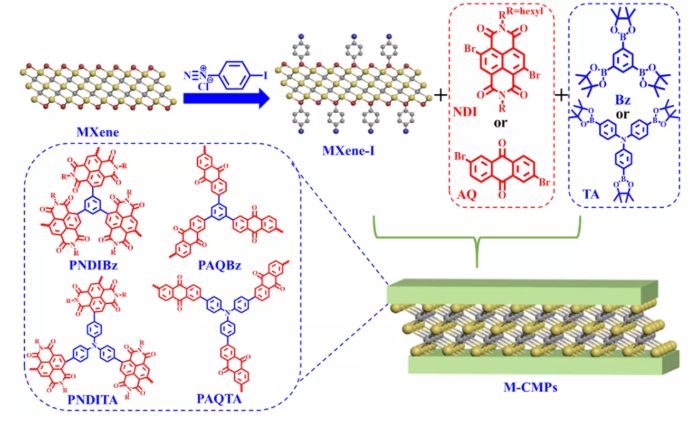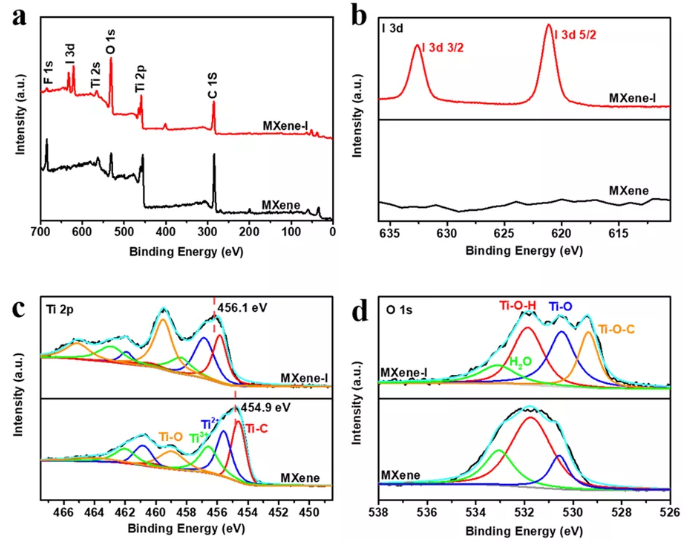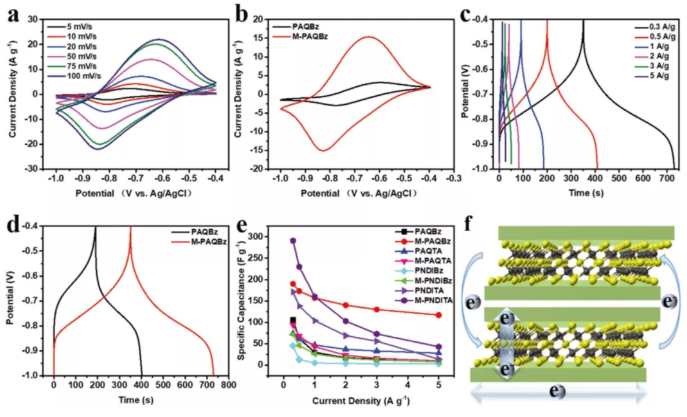MXene-based conjugated microporous polymer sandwich and its supercapacitor
QQ Academic Group: 1092348845
Detailed
【Research Background】
MXene is a two-dimensional transition metal carbide and/or carbonitride with excellent electrical conductivity, hydrophilic surface and mechanical stability. Due to its unique chemical and physical properties, it is used in energy storage devices such as batteries or capacitors, sensors And catalysts have been widely used in many fields. However, due to the strong interlayer van der Waals force and the interaction with water and oxygen in the environment, MXene nanosheets are prone to accumulation and oxidation, which significantly reduces their specific surface area, limits the effective use of the interface and severely affects its performance. Therefore, how to improve the stability of the Mxenes material and keep the material with good structure and performance has become an urgent problem to be solved.
【Job Introduction】
Based on the functionalization of two-dimensional materials such as graphene and molybdenum sulfide and its series of work foundations in energy conversion and storage device applications (Adv. Mater. 2015, 27, 6714; Chem. Mater. 2015, 27, 7403; Angew . Chem. Int. Ed. 2016, 55,6858; Mater. Chem. Front. 2017, 1, 278; ACS Sustainable Chem. Eng. 2019, 7,11540). Recently, Nanchang University/Jiangxi Normal University Professor Chen Yiwang, Professor Yuan Kai’s research group and others have demonstrated a conjugated microporous polymer to covalently modify MXene to prepare a series of MXene-based conjugates with a sandwich structure. Microporous polymer (M-CMP) nanosheets. The prepared M-CMPs not only have the hierarchical porous structure and high specific surface area of CMPs, but also inherit the two-dimensional structure and high conductivity of MXene, and at the same time inhibit the oxidation of MXene. This unique sandwich structure is essential for electrochemical energy storage. When M-CMP is used as the electrode material of supercapacitors, by virtue of its improved structure, M-CMP has a higher capacitance than MXene and CMP without MXene. The article was published in the international journal Small Methods. Yang Weizu and Huang Bingyu are the co-first authors of this article.
[Picture Introduction]

Diagram 1: Synthesis diagram of M-CMPs

Figure 1. XPS spectra of MXene and MXene-I (a); I 3d high-resolution spectra of MXene-I (b); Ti 2p (c) and O 1s (d) spectra of MXene and MXene-I.

Figure 2. The morphological characterization of M-PAQBz. SEM image (a-c); TEM image (d), inset is the selected area electron diffraction image of M-PAQBz; HRTEM image (e) and corresponding element distribution diagram (f).

Figure 3. CV curves of M-PAQBz at different scanning speeds (a); CV diagrams of M-PAQBz and PAQBz at 50 mV s-1 scanning speeds (b); GCD diagrams of M-PAQBz at different current densities (C); GCD curve of M-PAQBz and PAQBz at 0.3 A g-1 current density (d); M-CMPs and corresponding CMPs at 0.3-5 A g-1 current density of rate performance graph (e) ; Schematic diagram of electron transfer path during charge/discharge (f).
【in conclusion】
Covalently modified MXene by conjugated microporous polymer, successfully prepared a series of MXene-based conjugated microporous polymer (M-CMP) nanosheets with sandwich structure and used them as supercapacitor electrode materials . The results show that this strategy can simultaneously inhibit the stacking and oxidation of MXene nanosheets. In addition, the prepared M-CMPs not only have a hierarchical porous structure and a large specific surface area, but also inherit the two-dimensional structure and high conductivity of MXene. When used as a supercapacitor electrode material, M-CMP exhibits a higher capacitance than MXene and CMP without MXene. The reason for the increase in capacitance can be attributed to the unique sandwich structure of M-CMPs, which combines the advantages of MXene and CMPs. It has high conductivity and high specific surface area, thereby increasing the effective electrochemical active area and exposing more active sites. , And finally obtained a higher capacitance. This work not only provides a method for solving the stability of MXene materials, but also has the potential to prepare high-performance MXene nanocomposites for use in the field of energy storage/conversion.
Weizu Yang, Bingyu Huang, Longbin Li, Kaiyang Zhang, Yizhe Li, Jun Huang, Xiannong Tang, Ting Hu, Kai Yuan,* and Yiwang Chen*, Covalently Sandwiching MXene by Conjugated Microporous Polymers with Excellent Stability for Supercapacitors, Small Methods, 2020 , DOI:10.1002/smtd.202000434
Source: Energist Energy Scholar
This information is from the Internet for academic exchanges. If there is any infringement, please contact us and delete it immediately
- Previous: MXenes: a star materia
- Next: IF 14.1! Tumor-derived


 mxene academic
mxene academic